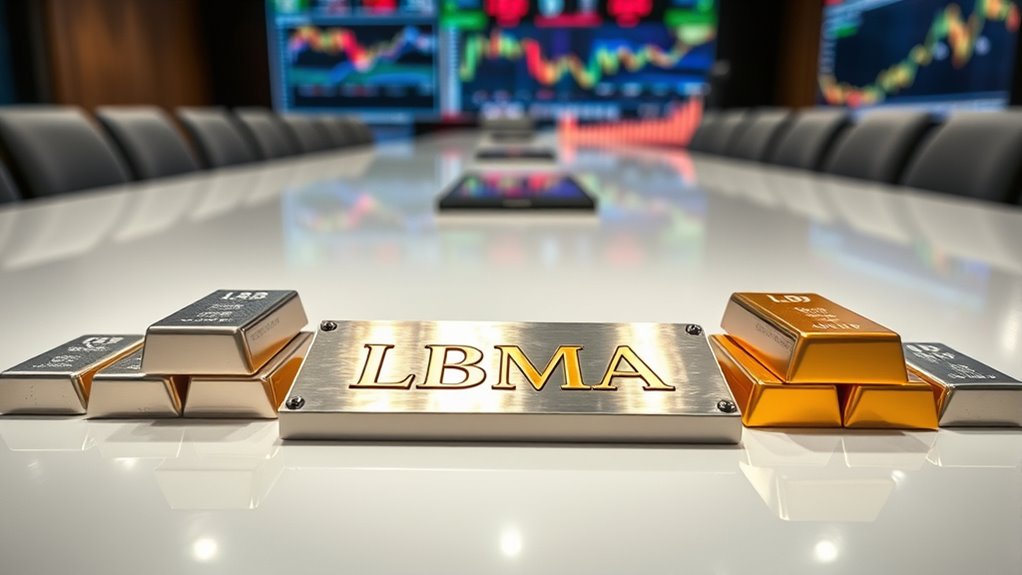The LBMA oversees the global trading of gold and silver, setting daily benchmark prices through transparent electronic auctions. Twice daily for gold and once for silver, major banks and traders submit bids and offers, with prices adjusted until supply and demand balance. These fixings serve as key references for contracts, retail prices, and market confidence. If you’re curious about how this process impacts the precious metals market, there’s more to explore below.
Key Takeaways
- LBMA oversees OTC trading and sets standards for precious metals like gold and silver globally.
- It conducts daily price fixings to establish reliable benchmarks for gold and silver prices.
- Gold fixings happen twice daily using an electronic auction among major bullion banks.
- Silver price fixing occurs once daily via electronic auction managed by ICE Benchmark Administration.
- These benchmarks influence global trading, contract settlements, and retail bullion pricing.

Have you ever wondered how the daily prices for gold and silver are determined and why they matter? The London Bullion Market Association (LBMA) plays a central role in this process. It’s the global authority overseeing over-the-counter trading in precious metals, including gold and silver. The LBMA sets and enforces standards for refining, assaying, trading, and storage of these metals among its member institutions, which include banks, refiners, traders, and logistics providers from around the world. With more than 150 members, the LBMA maintains the integrity of the market through its London Good Delivery List, accrediting refineries that meet strict international standards for weight, purity, and ethics. This accreditation ensures that the bars traded are of high quality, fostering trust among market participants and investors alike.
The main purpose of the LBMA’s price fixing is to create a reliable, daily benchmark for gold and silver prices used globally. These benchmark prices serve as reference points for settling contracts and guiding trading decisions across markets. While the fix prices mainly target the wholesale market, they also influence retail prices and serve as indicators for investors buying or selling bullion. The process aims to reflect real supply and demand dynamics among the largest OTC market participants, providing a transparent and authoritative snapshot of market conditions. The fixed prices are published in US dollars and other major currencies, but the primary settlement is always in USD, which is the dominant currency in global commodities trading. The LBMA’s prices are widely regarded as the most authoritative gold and silver benchmarks in the world. Additionally, the transparency of the process is supported by strict compliance standards for all participants involved. The process also incorporates robust oversight to prevent market manipulation and ensure fair pricing. The oversight is reinforced by international regulatory standards, ensuring a high level of trust in the benchmark process.
The LBMA’s price fixing establishes a trusted global benchmark reflecting supply and demand in precious metals markets.
The gold price fix occurs twice daily at 10:30 AM and 3:00 PM London time, using an electronic auction platform. Fifteen major bullion banks and trading firms participate as direct bidders. These firms submit bids and offers until supply and demand balance out, with the process repeating in rounds. Each round adjusts the price slightly until a consensus is reached, resulting in the official fix price, which then guides large transactions and derivatives worldwide. This process guarantees transparency and stability, ensuring that the price accurately reflects the market’s current state. The use of electronic auction platforms enhances the efficiency and fairness of the process, reducing the potential for manipulation.
For silver, the fix is set once daily at noon London time through a similar electronic auction, managed by the ICE Benchmark Administration. Participants input buy and sell volumes, and an algorithm matches orders within a tolerance range, adjusting the price until equilibrium is achieved. The final silver fix is published immediately, providing real-time data to global markets. All participants must follow strict conduct standards aligned with international regulations, reinforcing the integrity of this essential benchmark system. Market participants rely heavily on these benchmarks for trading decisions and risk management. This reliance underscores the importance of maintaining high standards of transparency and security within the process.
Frequently Asked Questions
How Does LBMA Influence Global Gold and Silver Prices?
You might wonder how LBMA influences global gold and silver prices. It does so by setting benchmark prices through its daily fixing process, involving major banks that determine official rates based on supply and demand. These prices serve as widely accepted standards for trading, contracts, and investment products worldwide. Because of LBMA’s extensive market reach and transparency, its fixings help stabilize and harmonize prices across different regions.
Who Are the Main Participants in Lbma’S Price Setting?
You’ll find that the main participants in LBMA’s price setting include major banks like JPMorgan Chase, Goldman Sachs, Citibank, and Morgan Stanley, along with trading firms and refiners. These entities actively contribute to the electronic auction process, helping establish the daily gold and silver prices. Their participation guarantees the benchmarks reflect current market conditions, maintaining transparency, integrity, and trust in the global bullion market.
What Are the Transparency Measures in Lbma’S Price Fixing Process?
Imagine peering through a crystal-clear window into the gold market. You’ll see that the LBMA’s transparency measures include electronic platforms that reveal aggregate order flow, making price discovery more open and efficient. Auctions provide real-time insights, reducing volatility. Additionally, databases and lists promote responsible sourcing, while regulations and advanced monitoring tools act like vigilant guards, ensuring fair trading. All these efforts shine a light on market integrity, fostering trust and clarity.
How Has Lbma’S Role Evolved Over the Past Decade?
Over the past decade, you see LBMA’s role has expanded considerably. It now governs a broader network of global firms, promoting transparency and ethical standards through initiatives like the Good Delivery List and Responsible Sourcing. You’ll notice it’s become more regulated, with its benchmarks overseen by authorities like the FCA. LBMA actively strengthens market integrity, fosters international partnerships, and adapts governance to guarantee trust and stability in the precious metals market.
What Are the Criticisms and Controversies Surrounding LBMA?
You see a trusted industry standard, but beneath that lies controversy. Critics argue LBMA’s Responsible Sourcing Program fails to prevent human rights abuses and illicit trade. Legal cases question its certification accuracy, while transparency remains lacking. These issues threaten investor trust and industry integrity, highlighting the need for reforms. Despite its reputation, LBMA faces significant criticism for not fully ensuring responsible gold sourcing and maintaining industry standards.
Conclusion
Even if you’re skeptical about the LBMA’s price fixing, understanding its role helps you grasp how gold prices stay transparent and reliable worldwide. Sure, it’s complex, but knowing who influences these prices gives you confidence in your investments. Don’t dismiss it as just industry chatter—recognizing the LBMA’s impact can empower your financial decisions. Staying informed means you’re better prepared to navigate the gold market’s ebbs and flows.
Helen brings a wealth of experience in investment strategy and a deep passion for helping individuals achieve their retirement goals. With a keen understanding of market dynamics, Helen has been instrumental in shaping the vision and direction of Gold IRA Markets. She specializes in creating innovative solutions that align with our clients’ long-term investment objectives.










